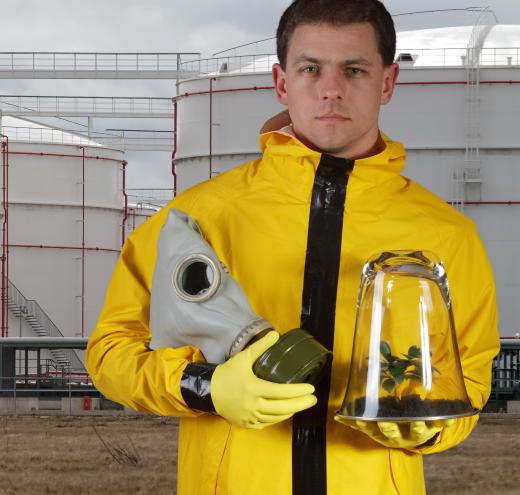What is Hydrazine?
 Mary McMahon
Mary McMahon
Hydrazine is a clear liquid which is used in a number of applications, most notably in fuel mixes for rockets and jet engines. It is created synthetically by chemical companies, and large amounts of it are manufactured every year to meet the demand for it. This chemical is toxic, posing significant human health risks, and in industries where people work with it, they are typically offered extensive training so that they can handle it safely and effectively.
The chemical formula for hydrazine is N2H4. It has been synthesized since the late 1880s, with the modern technique involving sodium hypochlorite and ammonia, which are reacted to form hydrazine. Hydrazine is a fuming chemical, and it is also highly corrosive and unstable, making it sometimes challenging to handle and ship. Because of the human health risks associated with hydrazine, it is usually tightly secured for travel.

In addition to being used in rocket fuels, hydrazine also appears in photo developer, flux agents, boiler water treatment, fuel cells, fluxes, and chemical agents used in polymerization. It is recognizable by its odor, which is faintly reminiscent of ammonia, with a musty undertone. Because of its instability and corrosiveness, containers which hold hydrazine are generally well labeled, as are products which contain this chemical.

Hydrazine can enter the environment in a number of ways, which is a concern for environmental agencies like the Environmental Protective Agency in the United States. It can be spilled, entering the soil and groundwater, and it also readily evaporates, dispersing itself into the air. Hydrazine contamination can also occur when rockets and their components fall to Earth, and hydrazine production carries contamination risks as well. Once hydrazine enters the environment, it can be challenging to clean up.

Exposure to hydrazine can result in irritation to the mucus membranes, leading to coughing and sore throat. Long-term or high exposure will cause nervous system damage, and attack the liver and kidneys as they attempt to process the toxin. Hydrazine can also cause reproductive harm, and it is believed to be a carcinogen. Most people will not interact with this chemical in the course of their lives, and in the event that contamination puts people at risk, citizens will typically be notified so that they can protect themselves.
AS FEATURED ON:
AS FEATURED ON:















Discuss this Article
Post your comments